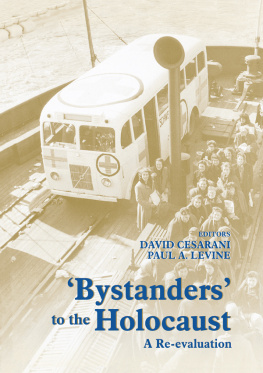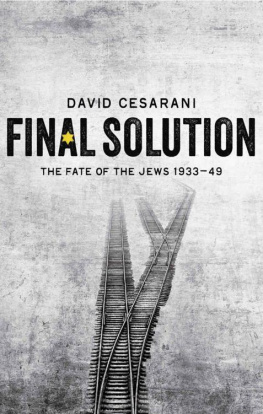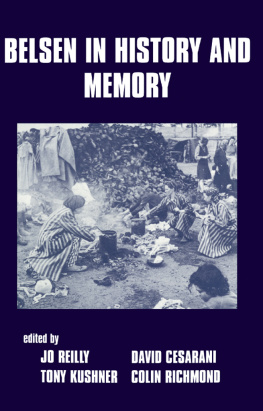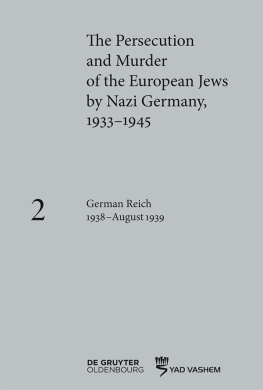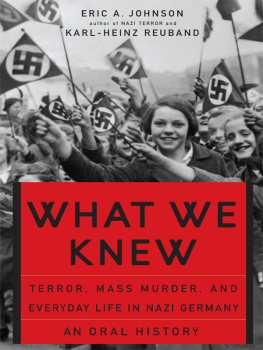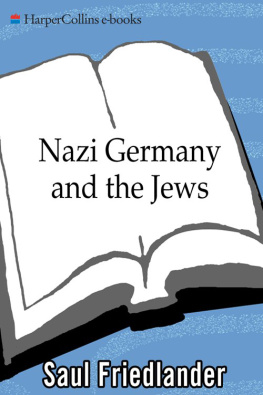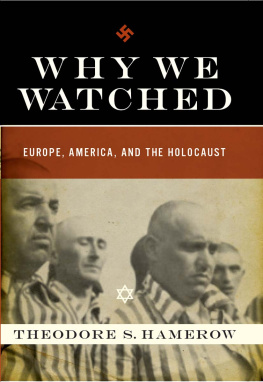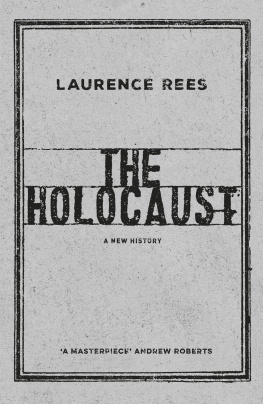BYSTANDERS TO THE HOLOCAUST
Books of Related Interest
In Search of Refuge
Jews and US Consuls in Nazi Germany 19331941
Bat-Ami Zucker
Doing Business with the Nazis
Britains Economic and Financial Relations with Germany, 19311939
Neil Forbes
Switzerland and the Second World War
Georg Kreis, with a Foreword by David Cesarani
Escape Through Austria
Jewish Refugees and the Austrian Route to Palestine
edited by Thomas Albrich and Ronald
Belsen in History and Memory
edited by Jo Reilly David Cesarani, Tony Kushner, and Colin Richmond
Holocaust Literature
Schulz, Levi, Spiegelman and the Memory of the Offence
Gillian Banner, with a Foreword by Colin Richmond
First published in 2002 in Great Britain by
FRANK CASS PUBLISHERS
Published 2013 by Routledge
2 Park Square, Milton Park, Abingdon, Oxon 0X14 4RN
711 Third Avenue, New York, NY 10017, USA
Routledge is an imprint of the Taylor & Francis Group, an informa business
Copyright 2002 Frank Cass & Co. Ltd.
All rights reserved. No part of this publication may be reproduced, stored in or introduced into a retrieval tem, or transmitted, in any form or by any means, electronic, mechanical, photocopying, recording or otherwise, without the prior written permission of the publisher of this book.
British Library Cataloguing in Publication Data
Bystanders to the Holocaust: a re-evaluation
1. Holocaust, Jewish (19391945) Foreign public opinion, American
2. Holocaust, Jewish (19391945) Foreign public opinion, British
3. Holocaust, Jewish (19391945) Foreign public opinion, Swiss
4. Holocaust, Jewish (19391945) Foreign public opinion, Swedish
5. Holocaust, Jewish (1939-1945) Government policy United States
6. Holocaust, Jewish (1939-1945) Government Policy Great Britain
7. Holocaust, Jewish (1939-1945) Government policy Switzerland
8. Holocaust, Jewish (1939-1945) Government Policy Sweden
I.Cesarani, David II.Levine, Paul A.
940.5318
Library of Congress Cataloging-in-Publication Data:
Bystanders to the Holocaust : a re-evaluation / edited by David Cesarani, Paul A. Levine.
p. cm.
Includes index.
ISBN 978-0-714-68243-3 (pbk)
1. Holocaust, Jewish (19391945)Moral and ethical aspects. 2. Holocaust, Jewish (1939-1945)Social aspects. 3. Holocaust, Jewish (19391945) Historiography. 4. World War,
1939-1945 Collaborationists. 5. World War, 1939-1945 Jews Rescue.
I. Cesarani, David. II. Levine, Paul A.
D804.3 .B95 2001
940.5 318dc21
2001006178
This group of studies first appeared in
Bystanders to the Holocaust: A Re-evaluation
a special issue of The Journal of Holocaust Education, Vol.9, Nos.2 and 3
(Autumn/Winter 2000) published by Frank Cass and Co. Ltd.
Contents
David Cesarani and Paul A. Levine
David Cesarani
Tony Kushner
Meredith Hindley
Jacques Picard
Raya Cohen
Sven Nordlund
Karin Kvist
Paul A. Levine
Sune Persson
David Cesarani and Paul A. Levine
List of Illustrations
Between pages 148 and 149
Acknowledgments
The editors would like to thank Mia Lwengart, Programme Coordinator at the Programme for Holocaust and Genocide Studies at the University of Uppsala, for her essential contribution to the colloquium on bystanders and this publication, and Dr Jo Reilly, Parkes Centre for the Study of Jewish/non-Jewish Relations, University of Southampton, and co-editor of the Journal of Holocaust Education. The Institute for Contemporary History, London, supported the colloquium at an early stage. The following took part in the colloquium and the editors wish to acknowledge their stimulating input: Professor Kristian Gerner, Professor Dalia Ofer, Dr Gulie Neeman Arad, Stphane Bruchfeld, and Kjell Grede, who presented his extraordinary film Good Evening, Mr Wallenberg. Professor Harald Runblom, Director of the Centre for Multiethnic Research and the Uppsala Programme for Holocaust and Genocide Studies, participated in the colloquium and his continuing support for the bystanders project and wise counsel have been invaluable. Graham Hart, our editor at Frank Cass Publishers, shepherded the volume into production and offered much helpful advice. Frank Cass himself takes a personal interest in the publications which bear his name, many of which would never see the light of day without his commitment to education about the Holocaust.
DAVID CESARANI and PAUL A. LEVINE
I
Despite the commencement of a new millennium and predictions, even aspirations, that the bloody history of the twentieth century would be laid to rest at the stroke of midnight on 31 December 1999, there has been no let up in the volume of scholarship, popular history, novels, films, drama, poetry, artwork, museums, memorials or controversies centring on the persecution and mass murder of the Jews between 1933 and 1945, universally known as the Holocaust.
These two distinct groups were not always considered in the same breath. For a long while, the attitudes and actions of the German people and those under German domination during the war years were treated separately from the conduct of the democracies in the 1930s, or the responses of the neutral states and the Allies in the 1940s. The behaviour of the latter group was commonly subsumed under such headings as allied responses or attempts at rescue. The term bystanders was not commonly used. However, in an influential historiographical study published in 1987, Michael Marrus gathered a discussion of the responses of the Allies, the neutral powers, the Vatican, and the Jews of the free world under the title Bystanders. In a book published five years later, Raul Hilberg used Bystanders By the end of the decade Lipstadt articulated the received wisdom that these groups had always been viewed as bystanders.
The erosion of pre-existing conceptual partitions was accelerated by the flood of revelations about the depth of economic collusion between the neutrals and the Nazi war machine, their readiness to profit from genocide, and the extent of Allied knowledge of the mass murder of the Jews as compared to the paucity of their response. Lipstadt notes that Many of these bystanders have spent fifty years protesting their innocence. But historians have repeatedly demonstrated and the recent stories reaffirm that they were not innocent and virtually no one, including the American public, was ignorant. Such exchanges have polarised rather than clarified the terms of debate and done little to advance historical understanding.
This volume grew out of an international colloquium convened in Uppsala, Sweden in September 1999 expressly to discuss the current state of bystander historiography. The Uppsala Colloquium on the Bystander in Holocaust History was organised by the recently formed Uppsala Programme for Holocaust and Genocide Studies in cooperation with the Parkes Centre for the Study of Jewish/non-Jewish Relations at the University of Southampton. The establishment of a Programme for Holocaust and Genocide Studies at the University of Uppsala, where the colloquium took place, was itself an expression of the new-found interest in Sweden for scholarly inquiry into the role which that country played during the Holocaust. Though it was recognised that the bystander in Holocaust history comprises a broad spectrum of historical actors, the colloquium chose to concentrate on the response of nations or other political entities (i.e. the Yishuv the Jewish community of Palestine) which because of their democratic character might have been expected to respond to the genocide differently from nations or agencies without a participatory and representative political framework. The colloquium thus set the stage for a necessary re-evaluation of the liberal, democratic bystander in Holocaust history.
Next page
